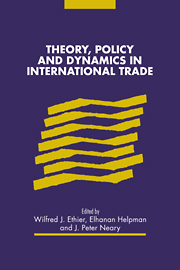Book contents
- Frontmatter
- Contents
- List of conference participants
- I Introduction
- II History, geography and the theory of trade
- 3 The hub effect: or, threeness in interregional trade
- 4 International trade and factor mobility with an endogenous land frontier: some general equilibrium implications of Christopher Columbus
- 5 Directions of lumpy country trade
- III The structure of simple trade models
- IV Policy towards international trade
- V Trade, growth and dynamics
- Index
5 - Directions of lumpy country trade
Published online by Cambridge University Press: 16 March 2010
- Frontmatter
- Contents
- List of conference participants
- I Introduction
- II History, geography and the theory of trade
- 3 The hub effect: or, threeness in interregional trade
- 4 International trade and factor mobility with an endogenous land frontier: some general equilibrium implications of Christopher Columbus
- 5 Directions of lumpy country trade
- III The structure of simple trade models
- IV Policy towards international trade
- V Trade, growth and dynamics
- Index
Summary
Introduction
The Heckscher–Ohlin Model of international trade makes a strong statement, in the form of the Heckscher–Ohlin (H–O) Theorem, about what goods a country will export and import. These and other implications of the H–O Model have been amply demonstrated by Jones (1956), as well as in his subsequent writings. The H–O Model has very little to say, however, about with whom these goods will be exchanged, even though there is evidence that the bilateral trade of at least some countries has a distinctive pattern that is reminiscent of the H–O Theorem, in that they export goods of different factor intensities to different trading partners. That is, countries are observed to export more capital-intensive goods to less capital-abundant countries, and less capital-intensive goods to more capital-abundant countries.
This behavior, which I will call “cross-over trade,” does not arise in the usual H–O model with free trade, although I have, in Deardorff (1987), explored how it can be obtained in such a model by introducing transportation costs of various sorts. Here, however, I will explore the fact that this same behavior is also likely to arise even with free trade within another modification of the H–O Model that Paul Courant and I have dealt with more recently. In Courant and Deardorff (1992) we show that if countries are “lumpy,” in the sense of having intra-national regions that differ in their relative factor endowments, then that lumpiness can contribute to a pattern of trade that is contrary to the H–O Theorem.
- Type
- Chapter
- Information
- Theory, Policy and Dynamics in International Trade , pp. 55 - 72Publisher: Cambridge University PressPrint publication year: 1993
- 1
- Cited by

